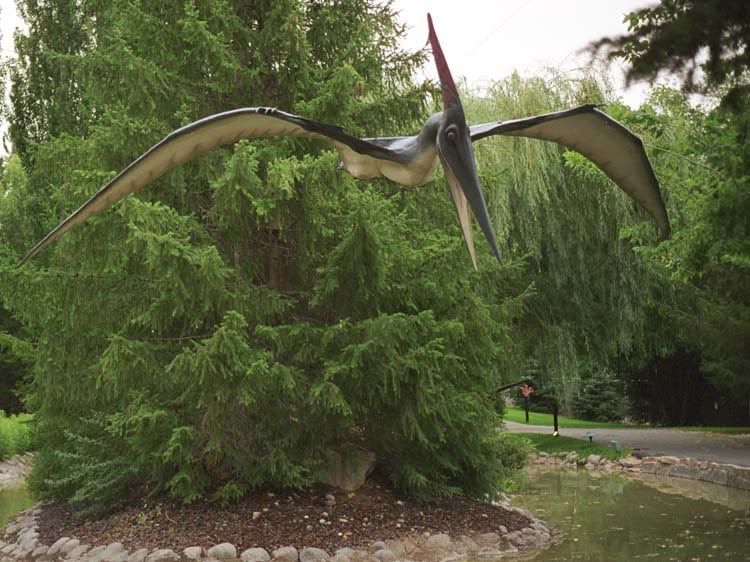Post by Barry the Baryonyx on Jul 8, 2007 21:12:20 GMT -5
Pteranodon

(C) 2000 by thangy Hodgman
Pteranodon (from Greek- "wing" and "toothless"), from the Late Cretaceous (santonian-campanian, 85-82 million years ago) of North America (Kansas, Alabama, Nebraska, Wyoming, South Dakota) was one of the largest pterosaur genera, with a wingspan of up to 9 m (30 feet).
Unlike earlier pterosaurs such as Rhamphorhynchus and Pterodactylus, Pteranodon had toothless beaks, like modern birds.
Pteranodont fossils have been generally found in the Cretaceous chalk beds of Kansas. These chalk beds were deposited at the bottom of what was once an epicontinental seaway on what is now the North American continent.The first Pteranodon skull was found on May 2, 1876, in Smoky Hill River, Wallace County, Kansas, USA, by S. W. Williston, a fossil collector working for Othniel Marsh. The Niobrara Formation is possibly the most famous unit here, and other fossils found in this formation include those of sea turtles, mosasaurs, and earlier birds.
Pteranodons were reptiles, but not dinosaurs. By definition, all dinosaurs were diapsid reptiles with an upright stance. Pterosaurs probably had a semi-upright stance. There is a small minority of paleontologists who think that the pterosaurs' stance could have been upright and that pterosaurs should therefore be included in the clade of dinosaurs (being derived theropods). Either way, dinosaurs and pterosaurs are certainly closely related.
Discovery and species
A number of species of Pteranodon have been named, the most well-supported being P. longiceps, with a wingspan of 9 m (30 feet) and the slightly smaller P. sternbergi, with a wingspan of 6 m (20 feet).
Other species include P. occidentalis, P. velox, P. umbrosus, P. harpyia, and P. comptus, though many are dubious and may be synonymous with the more well-known species. Notable authors who have discussed the various aspects of Pteranodon include Bennett, Padian, Unwin, Kellner, and Wellnhofer.
Paleobiology
The diet of Pteranodon is known to have included fish – fossilized fish bones have been found in the stomach of one Pteranodon, and a fossilized fish bolus has been found between the rami of another Pteranodon. Pteranodon's wing shape suggests that it would have flown rather like a modern-day albatross, soaring by navigating through thermals. This is a suggestion based on the fact that the Pteranodon had a high aspect ratio (wingspan to chord length) similar to that of the albatross – 9:1 for Pteranodon, compared to 8:1 for an albatross. However, other scientists have suggested that Pteranodon could flap their wings and fly with power. They flew long distances using large, light-weight wings.
Pteranodon was notable for its skull crest. These may have been used as mating displays, or it might have acted as a rudder, or perhaps both. It has been suggested that males of the species bore larger crests, but with fossil animals it is often difficult to tell whether differences in crest shape reflect different sexes or different species.
Consensus regarding the terrestrial locomotion of Pteranodon (whether it was bipedal or quadrupedal) has historically been the subject of debate. Today, most pterosaur researchers agree that that pterosaurs were quadrupedal, thanks largely to the discovery of several pterosaur trackways. The possibility of swimming has been discussed briefly in two papers (Bennett 2001 and Bramwell & Whitfield), and is currently being studied in detail at Michigan State University through the use of quantitative morphometrics and an Extant Phylogenetic Bracket (a morphologically comparative technique invented by Larry Whitmer).
© 2007 Answers Corporation


 Is it just us?
Is it just us?